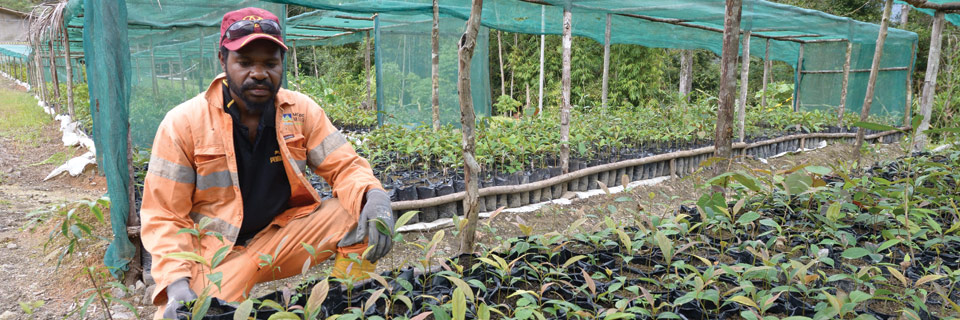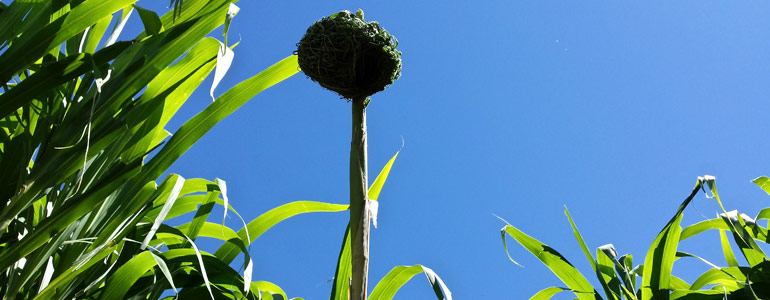LAND MANAGEMENT AND ENVIRONMENTAL CONSERVATION
We recognise that we are custodians of the land we affect and manage. While some aspects of our operations – particularly open-pit mining, waste and tailings deposition and the construction of physical structures – entail altering the physical landscape permanently, we believe that once mining has come to an end it is important to rehabilitate the land to effective and appropriate post-mining land use.
Rehabilitation and closure are therefore incorporated in overall planning from concept stage for new operations and during the life-of-mine for existing operations. This includes ensuring that the necessary funding mechanisms are in place. Continuous efforts are made to identify land for rehabilitation and, where feasible, we refurbish infrastructure for use by local communities.
BIODIVERSITY, LAND MANAGEMENT AND CONSERVATION
Harmony has in place strategies to manage the impacts of our operations on biodiversity. Environmental rehabilitation activities to restore the habitat for native species are ongoing.
Biodiversity management plans are implemented at all sites, either through their respective mine closure plans, environmental management plans or specific biodiversity action plans – whichever is the most appropriate. Biodiversity action plans involve the protection and conservation of indigenous plants as well as the planned, progressive removal of alien and invasive plant species. In addition, in the Free State, a nursery has been established on rehabilitated ground to cultivate indigenous species to be used to repopulate affected or remediated land.
Harmony has approximately 65 000ha of land under management in mining rights and disturbed areas that are under rehabilitation. None of our producing operations are in areas of high biodiversity value, inside or outside protected areas, and only one of our operational areas affects listed International Union for Conservation of Nature Red Data species (see below).
The following conservation projects are underway in the Free State:
- The Avianator Programme: This is a partnership with BirdLife South Africa; we provided the financial resources to design the curriculum and the funds for its implementation while Birdlife Africa rolled out delivery of the course. Harmony’s donation enabled BirdLife South Africa to work with 10 underprivileged schools during FY14 in the development and implementation of an environmental curriculum, related teacher training and adoption of bird-friendly areas on school premises to create environmental awareness. Workshops were held to review progress made and a prize-giving function was held in July 2014, post year-end, for the best performing school for environmental education
- The Endangered Wildlife Trust: In August 2013, Harmony signed a memorandum of agreement with and made a donation to the Endangered Wildlife Trust aimed at conservation of the vulnerable Sungazer Lizard (Smaug giganteus), which is endemic to the Highveld grasslands of the northern eastern Free State and south western Mpumalanga. The Sungazer Lizard’s habitat is found close to Harmony’s operations near Welkom. The Endangered Wildlife Trust’s conservation efforts focus on the lizard’s habitat and biology and it is in the process of trying to have this lizard proclaimed as South Africa’s national lizard. The Endangered Wildlife Trust’s Conservation Stewardship Programme, a key tool in habitat protection, seeks to formally proclaim suitable habitats and relevant levels of commitment from stakeholders ranging from biodiversity agreements to the proclamation of official nature reserves. Harmony seeks to identify areas in which it can assist with the Stewardship Programme on some of its properties
- Flamingo conservation project: Initial steps have been made regarding the conservation of the Lesser Flamingo in the Free State as their breeding sites are diminishing as a result of human encroachment and water pollution. We collaborated with BirdLife South Africa to host a workshop, held in October 2013, for all relevant parties, which identified the most suitable location for conservation of the Lesser Flamingo in the Welkom district. In addition this workshop marked the start of a partnership involving government, Harmony, non-government organisations and other private entities that will work towards a unified solution to flamingo conservation and protection in the Free State
Although Hidden Valley is not located in a biodiversity-protected area, five International Union for Conservation of Nature Red List species occur in the vicinity of the mine. There is no evidence that the mine has affected this critical habitat. These five species are the vulnerable tree kangaroo (Dendrolagus dorianus); an endangered species of tree kangaroo (Dendrolagus goodfellowi); the vulnerable nectar bat (Syconycteris hobbit); the vulnerable Harpy Eagle (Harpyopsis novaeguineae) and the critically endangered Long-Beaked Echidna (Zaglossus bruijni).
LAND MANAGEMENT AND RADIATION
Radiation has a health impact – a result of ingestion or prolonged exposure – and an environmental impact, given its extreme longevity and ability to sterilise affected areas. Licencing demonstrating responsibility from health, safety and environmental perspectives, is required from the National Nuclear Regulator for each site. Site-specific gamma energy surveys are conducted regularly and public safety assessments every five years in accordance with the National Nuclear Regulator. These assessments are based on specialist studies of human behaviour and air and ground water quality. The latest reports submitted to the National Nuclear Regulator were for Kusasalethu and Doornkop (2011) and for the Free State operations (2012).
Although radiation presents a lower level risk at our mining operations, it is nevertheless effectively planned for and managed. Spills are reported to the regulators and cleaned up after which close-out reports are submitted to the National Nuclear Regulator. Access control and signage is in place around process water dams and tailings dams to warn members of the public not to enter these areas.
In 2009, Harmony implemented a radiation quality management system which complies fully with the requirements of the National Nuclear Regulator and because it is ISO 9001-based, it requires continuous inspection. The quality systems audit conducted in May 2014 confirmed that Harmony was 100% compliant regarding its management system for the third consecutive year.
Surface radiation is managed by reducing the extent of affected areas, especially at legacy sites, in line with legal compliance, and by reducing our environmental liabilities. Radiological clearance surveys are conducted at decommissioned sites. Radiological clearance reports are compiled and submitted to the National Nuclear Regulator to ensure the future declassification of these areas. A closure report for the area surrounding Eland shaft has been submitted to the National Nuclear Regulator.
Rehabilitation has been prioritised at the joint metallurgical services site in the Free State. Rehabilitation is also paramount at the decommissioned shafts in the Free State and at Deelkraal in Gauteng, where high levels of radioactivity occur as it is an old uranium plant.
Harmony’s proposed rehabilitation methodology – which includes the use of phytoremediation – is supported by the Department of Mineral Resources and the National Nuclear Regulator. Phytoremediation involves the use of certain plants (these have been tested) to absorb radioactivity and our pollution sources from the ground into the plant structure. The harvested plants are disposed of at the tailings dam where the uranium and pollutants are consolidated. In this way, the pollution is removed without harm to or wasting of the topsoil. Phytoremediation is more environmentally friendly than traditional radiation rehabilitation methodologies which require the removal of large volumes of topsoil and sub-soils which creates huge cavities and further environmental deterioration. Phytoremediation has been successfully used in the Chernobyl area in Ukraine.
Rehabilitation and closure
| Operation | Mining right area | Land disturbed to date |
Land rehabilitated in FY14 |
|---|---|---|---|
| Kalgold | 991.0 | 425.81 | 0.21 |
| Kusasalethu and Deelkraal | 5 604.5 | 307.37 | 4.58 |
| Doornkop | 905.4 | 295.25 | 0.00 |
| African Rainbow Minerals shafts (1, 2, 3, 4, 6 and 7) | 5 980.2 | 354.20 | 7.23 |
| Joel (1 and 2) | 2 161.9 | 252.48 | 0.00 |
| Target (1, 2 and 3) | 4 327.0 | 256.91 | 0.00 |
| President Steyn South (Steyn 1, 2 and plant) | 1 846.8 | 61.96 | 0.00 |
| President Steyn North (Steyn 7 and 9) | 1 650.5 | 192.91 | 0.00 |
| Virginia, Masimong, Saaiplaas, Unisel, Merriespruit, Harmony and Brand | 22 583.0 | 3 348.62 | 11.22 |
| Bambanani, JMS, Harmony 1 plant | 2 355.8 | 1 411.60 | 0.00 |
| Eland, Kudu, Sable, Nyala, Tshepong, Phakisa, Western Holdings 5 | 10 798.7 | 1 579.53 | 5.67 |
| St. Helena 2, 4, and 8 | 4 912.4 | 445.78 | 0.00 |
| St. Helena 10 | 944.0 | 8.26 | 0.00 |
| Papua New Guinea | 4 098 | 475.1 | 18.84 |
| Total | 69 159 | 9 416 | 47.76 |
Only a small proportion of the land (15%) we manage has been disturbed by mining. Given that much of the affected land is in use, the opportunities for progressive and concurrent rehabilitation are limited. In FY14, the total rehabilitation liability for our South African operations was R2.20 billion (FY13: R2.11 billion). Harmony’s rehabilitation liabilities are fully funded in advance by means of trust funds and bank guarantees.
Rehabilitation of our decommissioned operations in the Free State and at Kusasalethu’s Deelkraal section in Gauteng started in FY12 with the aim of reducing our environmental liabilities, eliminating potential safety and health exposures, and working with provincial authorities to meet socio-economic imperatives. Demolition and rehabilitation have been finalised at five shafts in all – African Rainbow Minerals 2 and 3 shafts, and the Sable, Kudu and Harmony 3 shafts – and at the Brand 2 hostel. The waste rock dumps have also been reclaimed. This rehabilitation programme reduced our closure liability by R50 million in FY14 and provided employment for 200 local residents in FY14.
In Papua New Guinea, land clearing for mining and processing operations is closely managed by permits issued by the environment and community affairs departments. The high altitude and extremely rugged terrain and heavy rainfall result in very high levels of surface water run-off which makes it very challenging to rehabilitate cleared surfaces. In addition, Hidden Valley and Wafi are in a geologically active zone and experience frequent earthquakes and landslides. Steep surface rehabilitation is a dangerous and high risk activity. Staff are specifically trained and use special equipment to rehabilitate steep slopes.
The joint venture partners are preparing a template and guide for the preparation of a closure plan and the associated costs, which was completed in the fourth quarter. Site personnel will prepare a revised closure cost, using this guide, and submit the closure plan and costs to the owners and a third party auditor for review and agreement. Operational staff will play a greater role in the preparation of the revised closure plan and associated cost estimate.



